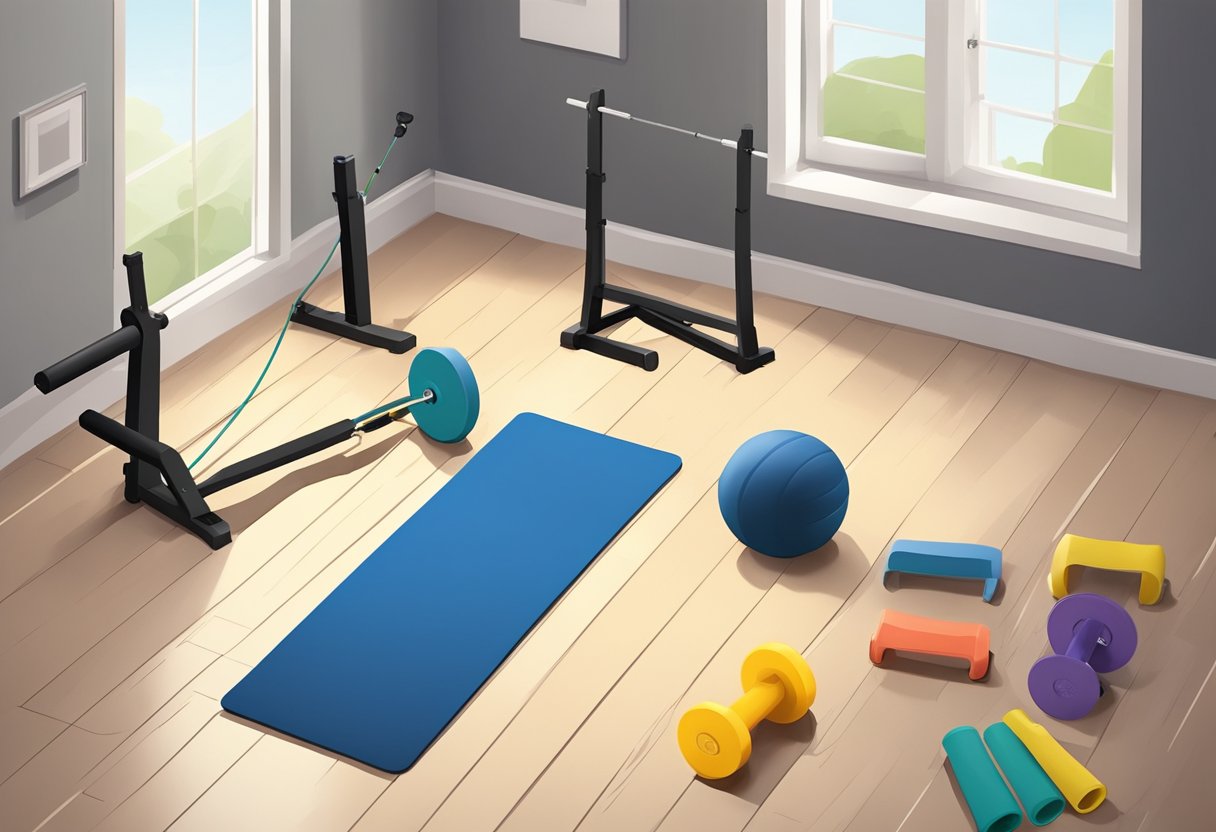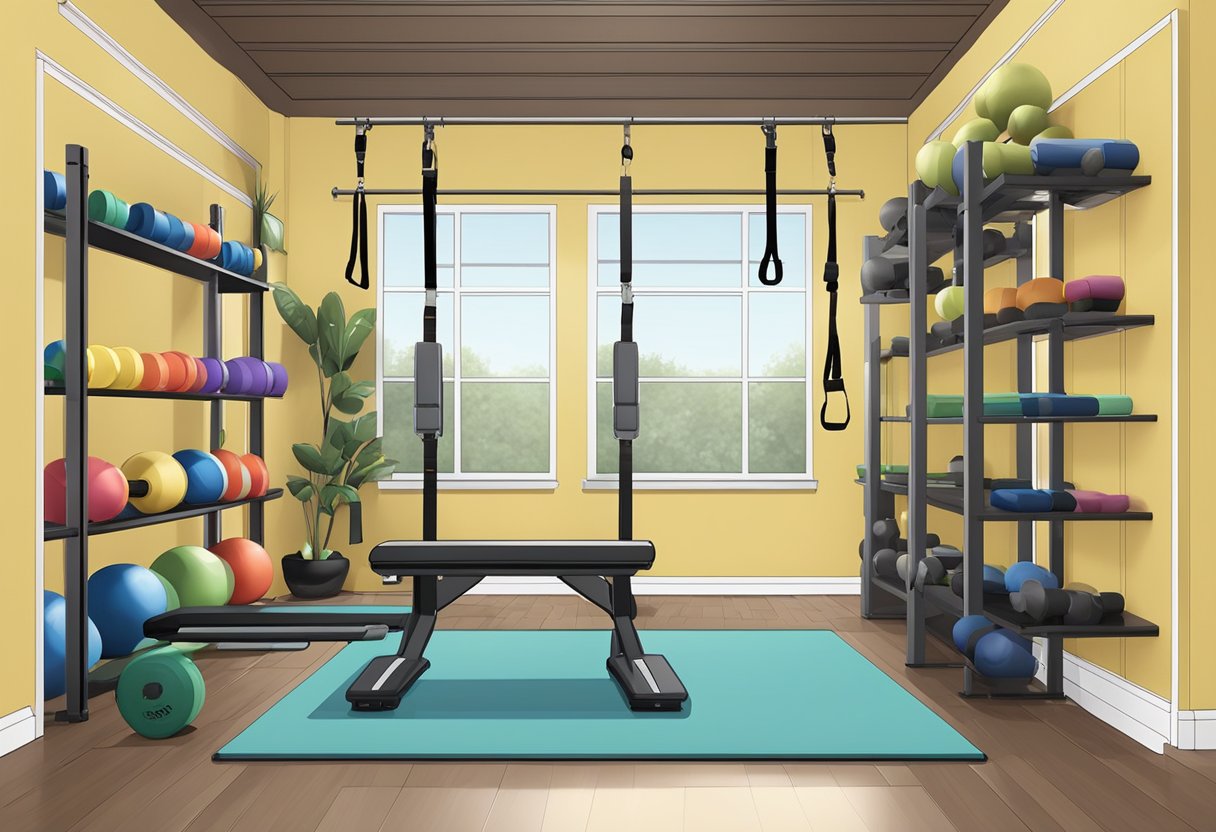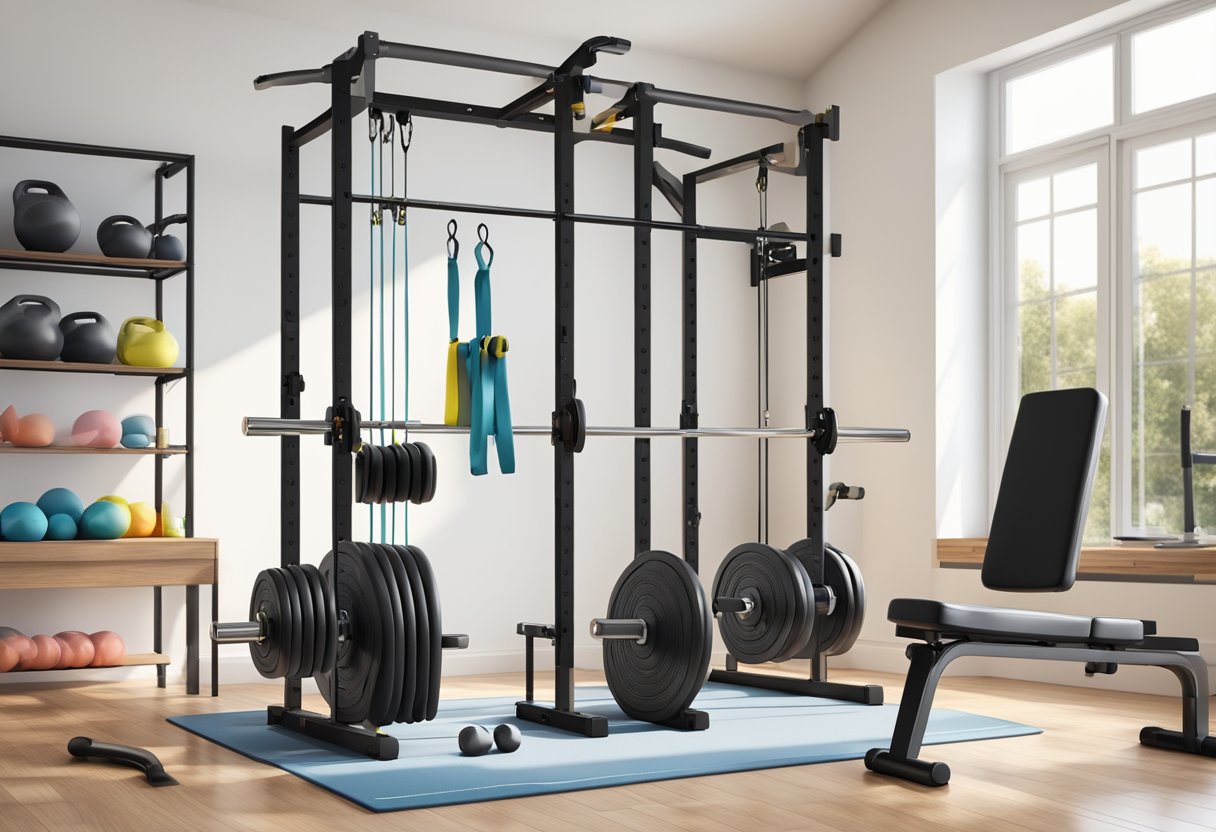Choosing between resistance bands and free weights for your home gym can seem daunting.
Resistance bands are ideal for those with limited space and budget. They offer portability and ease of use. On the other hand, free weights provide a consistent force profile and are excellent for building strength.

You don’t have to choose one over the other entirely. Incorporating both tools into your workouts can provide a well-rounded fitness routine.
Free weights might suit seasoned lifters better, while resistance bands are perfect for beginners or those looking to add variety.
Popular Posts
- Massage Gun vs. Foam Roller: Which Recovery Tool Reigns Supreme?
- 27 Best Calisthenics Exercises for Full-Body Strength and Fitness
- 10 HIIT Workouts for Busy Professionals: Max Fitness, Min Time
- Good Posture Working from Home: Optimize Your Workspace to Prevent Discomfort and Health Issues
- The Best Crossfit Exercises for Full-Body Conditioning
Splitting the article into smaller paragraphs makes it easier to read and understand.
Understanding the key differences will help you determine the best fit for your home gym. Both have their own advantages depending on your goals and lifestyle. Make an informed choice to maximize your workout potential.
Comparison Overview

Resistance Bands
Portability:
Resistance bands are highly portable. They are light and compact, making them easy to store and perfect for travel.
Cost:
Generally, resistance bands are more affordable than free weights. You can purchase a set for a fraction of the cost of a set of dumbbells.
Free Weights
Consistent Resistance:
Free weights offer a consistent force profile. A 10-pound weight always provides 10 pounds of resistance throughout the entire range of motion.
Building Raw Strength:
For strength training, free weights are more effective. They allow for heavier lifting, which is ideal for those focused on gaining strength.
Space Requirements:
Free weights require more space. If you have a dedicated home gym area, this might not be an issue.
Both Resistance Bands and Free Weights
Versatility:
Both options are versatile and can be used for a variety of exercises. You can target different muscle groups and adjust the intensity of your workouts.
Effectiveness:
Both tools are effective for achieving fitness goals. Your choice should depend on your specific needs, such as space, budget, and training objectives.
Pros and Cons
| Feature | Free Weights | Resistance Bands |
|---|---|---|
| Portability | Low | High |
| Cost | Higher | Lower |
| Consistent Resistance | Yes | No |
| Building Raw Strength | Highly Effective | Moderately Effective |
| Space Requirements | More Space | Less Space |
Choosing for Your Home Gym
When selecting between free weights and resistance bands, consider your fitness goals, available space, and budget. Each has unique benefits that can help you design an effective exercise routine tailored to your needs.
Defining Resistance Bands and Free Weights
When adding equipment to your home gym, it’s important to understand how these tools differ and what benefits each can offer.
What Are Resistance Bands?
Resistance bands are elastic bands used for strength training and physical therapy. Made typically from rubber or latex, they come in various lengths, strengths, and designs, such as looped bands, tube bands, and therapy bands.
One of their key features is variable resistance. This means the tension increases as the band is stretched, providing more resistance the further you pull. This makes them versatile for exercises targeting different muscle groups.
Resistance bands are lightweight, portable, and affordable, making them a convenient option for home workouts or travel.
What Are Free Weights?
Free weights include various equipment such as dumbbells, barbells, kettlebells, weight plates, medicine balls, and sandbags. These weights are used to perform exercises where the weight is moved freely in space, relying on gravity to provide resistance.
Dumbbells and barbells allow for a range of exercises that can target specific muscle groups. Kettlebells, weight plates, and medicine balls add versatility with functional movements and dynamic exercises.
Free weights can be incrementally increased to build strength progressively. They also demand more from your stabilizing muscles, enhancing coordination and balance.
Splitting the article into smaller paragraphs makes it easier to read and understand.
Benefits of Resistance Bands
Resistance bands offer several advantages that make them an excellent choice for home gym enthusiasts. They are highly versatile and portable, easy on the joints, and provide progressive resistance for effective muscle activation.
Versatility and Portability
Resistance bands can be used for a wide range of exercises, making them incredibly versatile. You can target various muscle groups and perform both strength training and stretching exercises.
Bands are also lightweight and easy to pack, making them perfect for travel. A set of resistance bands can easily fit into a small bag, allowing you to maintain your fitness routine anywhere.
These features make bands ideal for those with limited space or who are often on the go.
Joint-Friendly Exercises and Rehabilitation
Resistance bands provide a joint-friendly option for exercise, which is particularly beneficial for individuals recovering from injuries or with joint concerns.
The elastic resistance offered by the bands allows for smoother motions compared to free weights, reducing strain on joints.
Bands are frequently used in physical therapy settings due to their low impact and ability to aid in recovery from injuries. They allow for safe rehabilitation by providing controlled, gentle resistance.
Progressive Resistance and Muscle Activation
One of the most notable benefits of resistance bands is their ability to offer progressive resistance. This means the resistance increases as the band is stretched, which helps in effectively activating muscles throughout the entire range of motion.
This feature is particularly useful for both beginners and seasoned athletes, allowing for customized workouts that can be easily adjusted to match your fitness level.
With variable resistance, you can gradually increase the intensity of your workouts, promoting continuous muscle growth and strength gains.
Advantages of Free Weights
Free weights offer numerous benefits, including building muscle and strength, allowing for progressive overload, and mimicking natural movement patterns to improve stability. They are indispensable tools for enhancing overall fitness in a home gym setup.
Building Muscle and Strength Gains
Free weights are highly effective for building muscle and achieving strength gains. Unlike machines, they require you to engage multiple muscle groups simultaneously.
Dumbbells and barbells allow for a wide range of exercises, from bicep curls to deadlifts, targeting both specific muscles and larger groups through multi-joint exercises.
The resistance they provide is consistent, as free weights rely on gravity. This consistent load helps in achieving better hypertrophy and power development.
Because you can incrementally add weight, free weights also allow for precise tracking of strength gains.
Progressive Overload and Load Control
One of the most significant advantages of free weights is the ability to implement progressive overload. This principle involves gradually increasing the load or intensity of exercises to continually challenge your muscles and stimulate growth.
With adjustable dumbbells and weight plates, you can easily increase the weight in small increments. This ability to control the load closely makes free weights particularly effective for long-term strength and muscle development.
Moreover, free weights can be used in diverse training programs, whether your goal is hypertrophy, strength, or endurance.
Mimicking Natural Movement and Stability
Free weights are excellent for mimicking natural movement patterns, which translates well to real-world activities and sports.
Unlike some machines that lock you into specific paths, free weights allow for a more natural range of motion. This approach engages stability muscles, enhancing overall balance and coordination.
Exercises like squats or overhead presses necessitate the engagement of core muscles and stabilizers to maintain proper form. This builds comprehensive stability and functional strength.
Practical Considerations for Home Gyms
When setting up a home gym, space, cost, and safety are crucial factors. Each of these elements can significantly influence your decision between resistance bands and free weights.
Space and Gym Setup
The amount of space you have will dictate your home gym setup.
Resistance bands are highly portable and easy to store. They don’t require much room and can be hung on a simple hook or stored in a small drawer.
Free weights, such as dumbbells and barbells, typically need more space. You will need a sturdy rack or stand to safely store them.
Additionally, free weight exercises usually require a larger workout area to perform movements safely and efficiently.
A compact home gym can benefit significantly from resistance bands, while a larger space may accommodate a more extensive free weights setup.
Cost Implications
The cost of gym equipment can vary widely.
Resistance bands are generally more inexpensive compared to free weights. A basic set of resistance bands can be purchased for around $20-$30, offering multiple levels of resistance.
Free weights, on the other hand, can be more expensive. A single pair of adjustable dumbbells can cost anywhere from $50 to $300, depending on the brand and weight range.
If you opt for a more extensive set that includes barbells and weight plates, the cost can add up quickly.
Therefore, if budget is a constraint, resistance bands can be a more affordable option for building a home gym.
Safety and Injury Prevention
Safety should be a top priority in your home gym. Resistance bands pose a lower risk of injury because they are lightweight and place less strain on the joints. However, they need to be checked regularly for wear and tear.
A snapped band can cause an accident, so you should make sure to replace worn-out bands immediately.
Free weights require proper form and technique to avoid injuries. The risk of dropping heavy weights can lead to severe injuries, so using appropriate safety gear like weight benches and racks is crucial.
Additionally, you should have a good understanding of the exercises to prevent strains and sprains.
Structured training programs and possibly consulting a fitness professional can help minimize these risks, ensuring a safer workout experience.
Exercise Specifics and Examples
Selecting between resistance bands and free weights depends on your fitness goals and the specific exercises you aim to perform. Each option has unique benefits that cater to various aspects of strength training and muscle engagement.
Upper-Body Workouts
For upper-body workouts, resistance bands and free weights can target muscle groups like the chest, shoulders, and arms effectively.
Bench press can be done with free weights to develop chest strength and muscle definition.
Conversely, using a resistance band for chest presses makes the exercise more portable and can vary the tension to engage stabilizing muscles.
Pull-ups are essential for back and arm strength. Free weights can assist with weighted pull-ups when you’re ready for added intensity.
Resistance bands can offer assistance for beginners by reducing the effective weight, enabling you to perform more reps.
For biceps curls, free weights allow for precise loading and muscle isolation. Meanwhile, resistance bands can provide a variable resistance that increases as you curl, constantly challenging your biceps.
Lower-Body Exercises
Lower-body exercises help in building strength and mass in areas like the quads, hamstrings, and glutes.
For a fundamental move like the squat, free weights such as barbells and dumbbells can provide substantial resistance for muscle building.
Squats with resistance bands can also be effective, especially for improving form and adding resistance without requiring heavy equipment.
Glutes can be targeted with exercises like banded side steps and clam shells, which provide consistent tension throughout the movement.
Free weights can be used for weighted lunges and deadlifts to ensure substantial glute engagement.
For quads, front squats with a barbell or dumbbells are excellent choices.
Alternatively, resistance bands can be utilized for leg extensions or resistance band squats to activate and strengthen the quads.
Full-Body Routines
Full-body routines aim to engage multiple muscle groups for comprehensive strength and functional fitness.
Rows are crucial for back strength and posture. Using free weights like dumbbells or barbells can help develop robust back muscles.
Meanwhile, resistance bands are versatile for rows, allowing you to work on strength and range of motion even in tight spaces.
Functional movements like deadlifts and clean and press can be performed with free weights for full-body strength and power.
Resistance bands can be used to train similar movements, improving functional strength and providing an effective way to build muscle without needing bulky equipment.
Incorporating a mix of lower- and upper-body exercises within a full-body routine ensures balanced muscle development and improved overall functionality, whether you’re using free weights or resistance bands.
Supplementary Accessories and Equipment
Enhancing your home gym with supplementary accessories can optimize your workouts and maximize effectiveness. Different equipment pieces can serve complementary functions to both resistance bands and free weights.
Incorporating Additional Tools
Adding adjustable dumbbells provides versatility, allowing you to easily modify weights for different exercises without needing multiple sets of dumbbells.
These are ideal for those with limited space but who still want a comprehensive strength training regimen.
Loop bands and flat resistance bands can target specific muscle groups.
Loop bands are good for dynamic exercises like squats and lunges, while flat bands are effective for stretching and flexibility routines.
These bands, often made from latex or rubber, are easy to store and transport.
Including exercise bands with built-in handles offers another layer of versatility. They can simulate many traditional gym exercises, making them a useful addition to a compact home gym setup.
Combining Resistance Bands with Free Weights
Using resistance bands together with free weights creates varied and efficient workouts.
For example, pairing free weights with loop bands or flat resistance bands can increase tension and improve muscle activation. This is especially beneficial for compound movements like squats and bench presses.
When combining these, ensure your bands are securely anchored to prevent slipping.
Latex or rubber bands typically offer better grip and durability.
This combination can help balance strength and resistance training, catering to different fitness goals like strength gains and endurance.
Maintenance and Durability
When considering the maintenance and durability of your home gym equipment, both resistance bands and free weights have their specific requirements.
Resistance Bands:
- Material: Typically made of elastic materials like latex or synthetic rubber.
- Durability: They can be highly durable if maintained correctly. However, they may degrade over time with frequent use or exposure to sunlight and extreme temperatures.
- Care: Regularly inspect for tears or thinning. Clean with mild soap and water, and store them in cool, dry places to prolong their lifespan.
Free Weights:
- Material: Generally constructed from iron, steel, or other heavy-duty metals. Some have rubber or neoprene coatings.
- Durability: Extremely durable and can last a lifetime with proper care.
- Care: Wipe down after use to prevent rust, especially if they are made of uncoated metal. Store in a dry area and avoid dropping them from heights.
| Criteria | Resistance Bands | Free Weights |
|---|---|---|
| Material | Elastic (Latex/Synthetic Rubber) | Metal (Iron/Steel) |
| Durability | Moderate, susceptible to wear and tear over time | High, long-lasting with minimal wear |
| Care | Clean with mild soap, store away from sunlight | Wipe after use, store in dry locations |
Investing in quality products for both can improve their lifespan. Higher-quality resistance bands may cost more but are less prone to snapping, and premium free weights often have better rust-resistant coatings.
Adapting Workouts for Travel
When you’re on the move, maintaining your workout routine can be challenging.
Resistance bands are an excellent solution due to their portability and convenience. They take up minimal space in your luggage and can be used virtually anywhere.
In a hotel room, secure the band around a door handle or sturdy furniture to perform exercises like rows, chest presses, and squats.
These bands enable you to keep up with your strength training without requiring bulky equipment.
Parks offer an ideal outdoor setting where you can loop a resistance band around a bench or tree for routines such as assisted pull-ups or triceps dips.
The natural surroundings can also make your workout more enjoyable.
Travel frequently disrupts your normal schedule and access to a gym. Free weights, while effective, can be impractical to carry with you.
Resistance bands provide a versatile alternative that allows for a comprehensive workout without the need for carrying heavy gear.
Benefits of using resistance bands for travel workouts:
- Lightweight and compact
- Versatile exercises for different muscle groups
- Easily stored in luggage
- Can be used in various locations like hotel rooms and parks
Packing a couple of resistance bands ensures that you can adapt your workout regardless of your destination. Whether you’re in a compact hotel room or a spacious park, you can maintain your fitness routine seamlessly.
Frequently Asked Questions
When it comes to setting up a home gym, choosing between resistance bands and free weights involves various factors such as benefits, resistance levels, cost, space efficiency, risks, and effectiveness in muscle building and weight loss.
What are the benefits of using resistance bands over free weights for home workouts?
Resistance bands are portable and easy to store, making them perfect for limited spaces. They also offer variable resistance, which can target different muscle groups through a range of motions.
Can resistance bands provide enough resistance for strength training compared to free weights?
Yes, resistance bands can provide significant resistance for strength training. Bands can be layered or used in combination to match and, in some cases, exceed the resistance offered by free weights.
How do resistance bands and free weights compare in terms of cost and space efficiency for home gyms?
Resistance bands are generally more affordable and take up less space than free weights. This makes them a cost-effective and space-efficient option for home gyms.
What are the potential risks or disadvantages of using resistance bands during workouts?
Resistance bands can snap or break if not properly maintained, posing a risk of injury. Additionally, achieving very high resistance levels may be challenging with bands alone.
How does the effectiveness of resistance bands compare with free weights for targeted muscle building?
Free weights are generally more effective for maximal strength and muscle mass gain due to their consistent resistance.
However, resistance bands can be equally effective for functional strength and muscle endurance.
Can I achieve the same weight loss results with resistance bands as I can with free weights?
Both resistance bands and free weights can help you achieve weight loss.
The key is incorporating them into a consistent workout routine.
This routine should also include cardiovascular exercises and a balanced diet.









